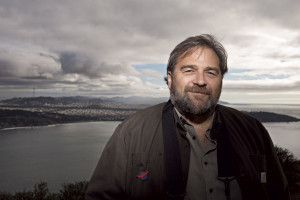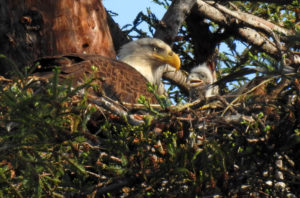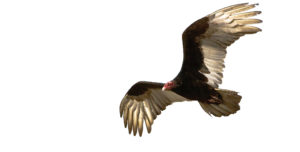
At first glance, the osprey is easy to overlook. Resting, it lacks the noble profile that made the bald eagle an American icon; in fact, the osprey’s head seems awkwardly small for its body. Orange eyes peer out from behind a black bandit mask. The feathers at the back often ruffle up, disheveled. It’s a little bit punk. A little bit geeky.
Hunting, though, the bird is something else. Circling high over the shallows, catching sight of a promising shadow or burst of sand, an osprey flicks from horizontal to vertical. Wings cant up and back over the head, beak juts down, right above a sharp star of talons—a spear hurling itself at the water. This single-minded devotion to fish and fishing is the bird’s defining characteristic. “There’s a handful of stories of an osprey maybe picking up an eel; there’s at least one of an osprey carrying something like a young grebe or a cormorant, and my guess is that they thought it was a fish. It was a mistake,” says Allen Fish, director of the Golden Gate Raptor Observatory, an organization that tracks raptor migration in the Bay Area.
And when the osprey emerges, soaking and hauling itself out on mighty wings, gaining the air and then pausing a moment to adjust the wriggling fish forward to reduce drag, well, a hunting osprey might not be noble, but it is incredibly cool.
Until recently, this was a rare sight in the Bay Area.
“The funny thing is there were no historical records of them nesting on the Bay,” says Tony Brake, who has been documenting the growth of the osprey population here for the past six years. “It’s kind of mysterious because it seems to be really good habitat.”
Osprey Days
Since 2013, the Mare Island Preserve has been hosting Osprey Days, a weekend of education and celebration about the newcomers that draws 300-500 visitors out to see them. Dolphin Charters runs boat tours that pass by the Mare Island nests, Tony Brake shares his latest research and Robin Leong give talks about the history of the shipyard. They serve fish tacos for lunch “in an homage to the osprey,” says Myrna Hayes, the preserve’s volunteer manager.
The Osprey Days of 2023 take place June 23, 24, and 25. More information here!
Ospreys occur all over the world, migrating thousands of miles, from Sweden to West Africa and Canada to Peru, but few documents show them breeding around San Francisco Bay. Naturalists like George Grinnell and Margaret Wythe, who surveyed the Bay Area for a 1927 report, called osprey a “very rare resident.” An excavation of the Emeryville Shellmound, a site of the Ohlone dating back 2,600 years, uncovered parts of loons, peregrine falcons, and barn owls—a total of 64 species—but no ospreys.
And even a casual observer would have noticed. Ospreys build big nests. That’s because they are big birds, with a wingspan just smaller than a bald eagle’s. In addition to their fishing feats, ospreys perform flamboyant display flights. The naturalist John James Audubon described the male wheeling high above the nest before diving back toward the incubating female, who “partially raises herself from her eggs, emits a low cry, resumes her former posture, and her delighted partner flies off to the sea, to seek a favourite fish for her whom he loves.” On top of all this, they are loud, calling kyew, kyew, kyew. But for centuries they have scarcely been mentioned.
That is, until in the early 1990s, when Robin Leong, a supervising naval architect at Mare Island Naval Shipyard in Vallejo and an avid birder, got reports from men in the field of a new bird nesting. He went out to investigate and first found a pair of ospreys on a pile driver on a floating barge. They fledged two young. The pile driver moved, but the ospreys persisted, as Leong noted on his spreadsheet, “hanging around.” Before long, Leong saw ospreys nesting on light poles on the island itself. When the shipyard, the first naval yard on the Pacific Coast, closed in 1996, equipment left behind included cranes, light towers, supports for ships in progress. The ospreys settled in. By 2011, 13 pairs had built nests in the spring.
At about this point, Brake moved to Point Richmond, and he realized he could see an osprey nest from his house—by the SS Red Oak Victory, a ship docked on the Richmond shoreline. And his friend Harvey Wilson, who lived in Alameda, found a nest there. Maybe, he and Wilson thought, there were more ospreys than people realized. “Initially, just out of our own curiosity, [we] started going around seeing if we could document the population,” Brake says.
Brake and Wilson ended up charting a booming species. As Brake suspected, ospreys weren’t just concentrated near Mare Island. A survey the next year found a pair trying to build near the San Mateo Bridge and a couple raising two chicks on a light pole at Hunters Point. By 2017, numbers were up to 61 young fledged from 43 nests, in locations ranging from Hercules to Pier 80 in San Francisco to Belmont Slough in the South Bay.
The ospreys might or might not have returned, but it’s clear that they have arrived. Which raises a question: Do these large, wild, fearsome fish predators prefer our built-up shoreline bristling with apartments, cargo ships, and manufacturing equipment? And what does it mean if they do?
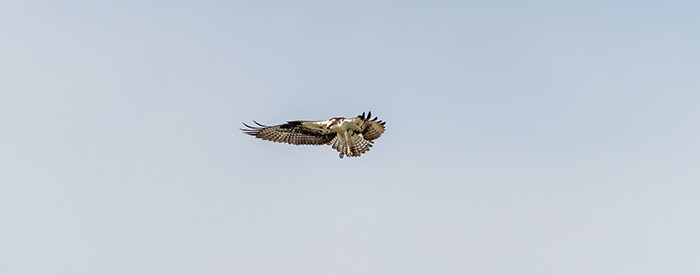
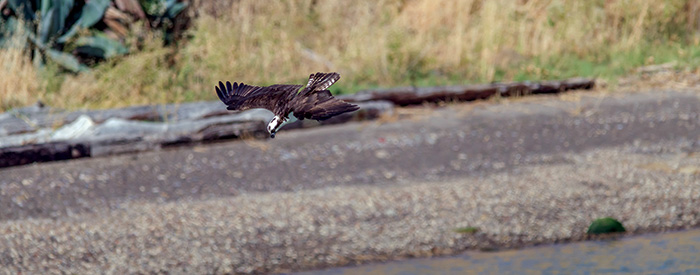
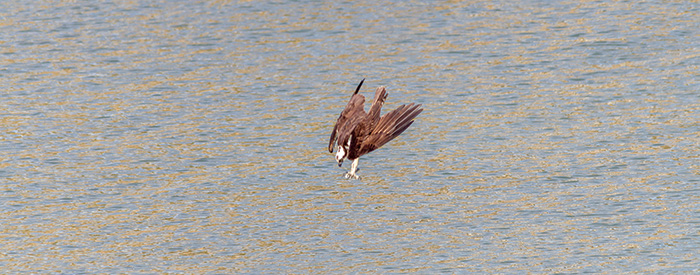

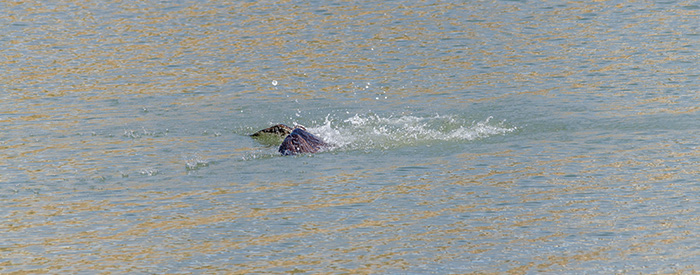

On top of a rust-red crane next to a gray ship draped with bunting, the ospreys are courting.
The SS Red Oak Victory is the last surviving supply ship built at the Richmond Shipyards, part of the Rosie the Riveter World War II Home Front National Historical Park. If the nearby crane, once used to lift and place sheets of iron on the ships, looks vaguely like a camel, then the osprey nest perches right on its hump. It’s only March (2017) and there are no eggs yet—the birds are still building, displaying, feeding each other. Their perch offers a view out over the water all the way to the Bay Bridge. The nest is large enough that where a robin would weave in a twig, the osprey has placed a tree limb.
Like most nesting birds, ospreys use what they find, and industrial areas like the shipyards provide ample inspiration. Six-foot-wide osprey nests can incorporate everything from kelp to cardboard to bicycle tires. Here, a yellow rope dangles in the breeze. As a tour of the ship passes underneath, the male floats up to the east.
A retired scientist who worked in molecular biology at UCSF, Brake counts and maps nests and records which parents successfully raise young to fledging. Coming back repeatedly, watching for egg laying, noting the characteristic motion of the female as she rips bits of fish to feed chicks too small to see over the lip of the nest, is different than birding, where you might glimpse a species once.
“It’s just a marvel that they manage to pull this off year after year,” he says.
It’s even more of a marvel because some of the sites near the Chevron oil refinery and the former Mare Island shipyard and the rooftops, channel markers, and cranes where the ospreys build aren’t exactly pristine wilderness. What makes the bays suddenly desirable when they’ve seemingly never been before? Are the birds sending us a message we should be able to decipher? For example, is climate change altering habitat, creating new opportunity? Allen Fish says, “Raptors for me aren’t birds; raptors are climate change indicators.” Ospreys are no exception.
Maybe, as a result of temperature shifts or some other disturbance, a new kind of fish has moved in. Certainly the fact that birds nest right next to each other—on adjacent light poles at times—indicates food is plentiful. Or maybe sediment washed into the bays from Gold Rush placer mining, dredged in some places until recently, now provides the shallow waters ospreys prefer?
Or does the now idle industrial equipment offer nesting opportunities along a shoreline traditionally treeless? Maybe those high perches on abandoned cranes, near the water, safe from raccoons, with excellent views of the Bay, are irresistible real estate.
No one is sure.
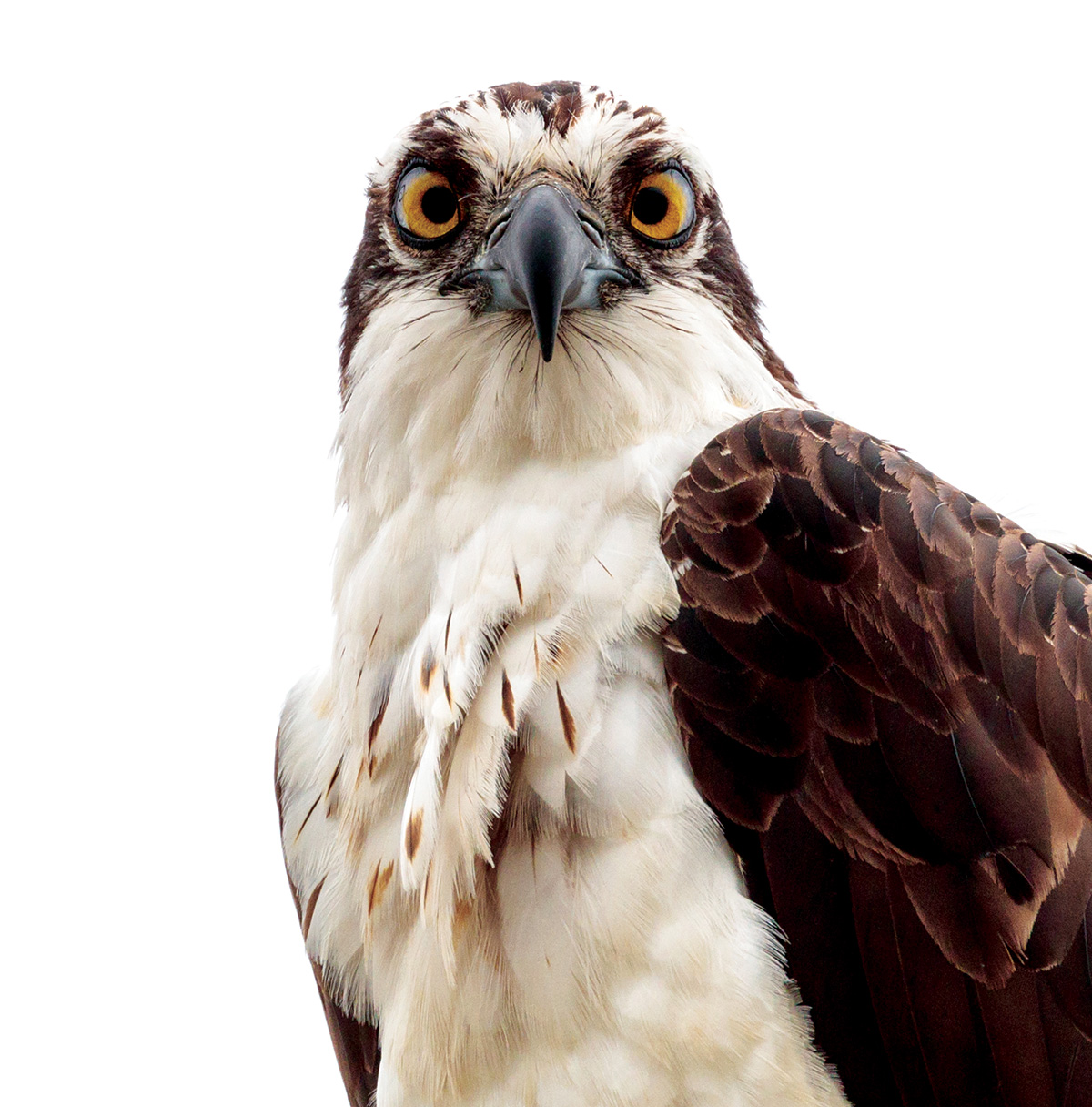
Either way, it doesn’t hurt that bald eagles are scarce. In his 18th-century book The Natural History of Carolina, Florida, and the Bahama Islands, naturalist Mark Catesby commented on the bald eagle’s criminal tendencies. The osprey, which he calls the Fishing Hawk, “seldom rises without a fish; which the Bald Eagle (which is generally on the watch) no sooner, spies, but at him furiously he flies; the Hawk mounts, screaming out, but the Eagle always soars above him, and compels the Hawk to let it fall; which the Eagle seldom fails of catching, before it reaches the water.” (Benjamin Franklin thought these thieving ways should have disqualified the eagle from representing America, deeming the national bird “of bad moral character” as “he does not get his living honestly.”) But bald eagles tend to be more people-shy than ospreys, which don’t seem to care if a raucous tour of a ship’s gunnery equipment takes place right beneath them.
The closest osprey population to those living by the Bay is at Marin’s Kent Lake, which at one point in the mid-1990s had 52 osprey nests. In 2008, though, when a couple of bald eagles settled in, the number of nesting ospreys plummeted. According to a report commissioned by the Marin Municipal Water District, given that Kent Lake is close to the Bay and that one population fell at the same time as another’s numbers rose, ospreys fleeing bald eagles might have learned to live on cranes rather than coastal redwoods and hence been the origin of these new residents.
Mare Island these days features parking lots reclaimed by bushes, houses with windows blown out, fire escapes that lead nowhere, signs advertising “office and industrial space.” In this landscape, the cranes from shipbuilding times are so outsize, this part of the island has the feel of Jurassic Park: two separate senses of scale operating in the same small space. An osprey wheels over the ferry parking lot and alights on a green crane, near its nest. Another nest sits on the top of a pulley. Even a dangling hook has sticks on top of it—the abandoned attempt of a great blue heron. In Ospreys: A Natural and Unnatural History, Alan F. Poole quotes a scientist who pictured the remote and wild birds of Scotland when he thought of ospreys and who wrote in 1911, “My surprise can therefore be imagined when I saw my first American Osprey’s nest. It was at a popular seaside resort in New Jersey, and perched on a tree overlooking a lake full of row boats and noisy holiday makers.” In his introduction to Poole’s book, Roger Tory Peterson writes, “Of all the raptors, the Osprey is the one that can live most happily with modern man, if given a chance.”
“Ospreys’ cosmopolitanness is outrageously exciting,” says Allen Fish. “How does an industrial environment provide what an osprey needs? We didn’t have industrial environments 300 years ago, so what is it that makes this work?”
In terms of nests, ospreys aren’t just indifferent to human constructions, they seem to prefer them. In Chesapeake Bay in the mid-’90s, all but 7 percent of thousands of ospreys nested on human-built structures. Brake says the most unusual nest he encountered was on a Mare Island palm—it was the only pair in the Bay Area nesting on a tree.
They like tall, exposed sites near water and maybe that’s all they need. Birds can focus on certain traits—of landscape, of mating partners—in an obsessive way. For example, in a study on widowbirds, an African species whose males’ tails grow very long in the breeding season, a scientist glued extra tail feathers to some males, creating tails longer than ever appeared naturally. These artificially enhanced males had more females in their territory than those who had tails of a normal length. Maybe ospreys have a similar idea of “more is better” when it comes to nest locations. It’s as if someone were tempting them: “You like dead trees; what if you found a spot even higher, and even more inanimate? Would you like it better?” Apparently so.
Of course, nesting in the middle of an industrial landscape has its risks. A chick raised on a power pole was electrocuted several years ago. Once, a neighbor mentioned to Brake that he’d seen a young osprey dangling from a piece of fishing line woven into the Red Oak Victory nest. Pulled from his role as counter and observer, Brake climbed up and cut the chick free. But the line had become embedded in its skin, so Brake and arborist James Woods brought the bird to WildCare to have the line surgically removed and the wound cleaned. Two days later, he says, he put the chick back in the nest.
And osprey and human interests do, sometimes, conflict. In Alameda, ospreys repeatedly tried to nest on the maritime ship Admiral Callaghan, where their nests were dismantled by the Maritime Administration. They finally settled onto a navigation light. Ospreys building on Pier 80 where they might have interfered with the America’s Cup yacht race also had their nests removed and destroyed. And pollution from human-dominated landscapes caused dramatic osprey population declines in the middle of the last century, as the insecticide DDT thinned osprey eggs and resulted in breeding bird declines of up to 90 percent along the northeast coast.
Pollution remains a concern, particularly near oil refineries. “There’s sort of an enigmatic question of, if the area’s so polluted, what the heck are the osprey doing coming back,” says Fish. “Actually, we can’t say ‘coming back,’” he reminds himself.
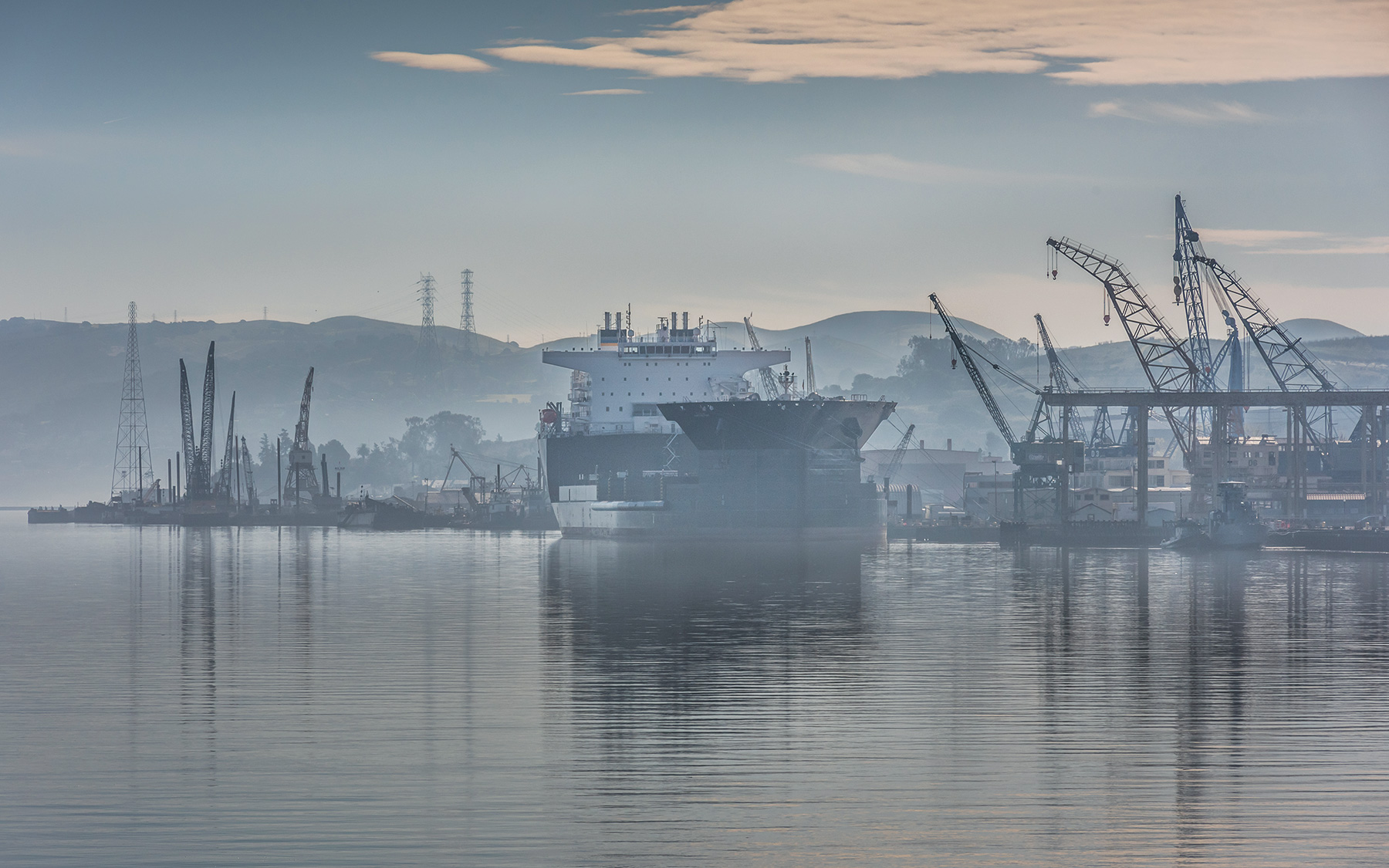
Animal history and human history often weave together, but sites like the shipyards at Mare Island and Richmond make the ties explicit. Exhibits chart humans migrating and then, sometimes, departing from these places as their purpose changed. In Rebecca Solnit’s essay “Abandon,” she writes that a “ruin” is “a human construction abandoned to nature, and one of the allures of ruins in the city is that of wilderness: a place full of the promise of the unknown with all its epiphanies and dangers.”
At the southeastern tip of the island at the Mare Island preserve, formerly a naval ammunition depot, ospreys have found another landscape in flux. A tourist can explore the visitor center, located in a 1934 bomb storage magazine with a porch covered in flowers in half barrels, then can wander along overgrown paths where the pavement is marked with spray-painted arrows pointing to osprey nests. There is another dense neighborhood of nests by the shore: light pole, channel marker, light pole, light pole. And another double-decker light pole.
Preserve manager Myrna Hayes, who only bought her first pair of binoculars recently as a 60th birthday present, spends days out there—putting on a Tyvek suit and pulling poison oak or stringing Christmas lights for a holiday hike, her pink headband holding back gray curls. The ospreys are another way to draw people to the preserve. Visitors send her excited texts about birds they’ve seen, post their sightings on Facebook. The presence of the osprey creates investment, on the part of the public, in this plot of land.
“That’s a quiet, stealthy guerrilla gift,” she says.
The arrival of a species so dramatic leaves us casting about for a way to frame our most recent arrival. Will it be treated with disdain, like raccoons that dive into urban life, leaving a trail of tipped-over garbage cans in their wake? Or with delight, as with peregrine falcon pairs that nest on the PG&E building, a San Francisco emblem? For now, just as the ospreys look at industrial landscapes and see nest sites, construction material, threats or benign passersby, human viewers look at the osprey and see shifting meanings: a citizen science project, a climate change harbinger, a gift.
The Golden Gate Audubon Society has installed a webcam at the Red Oak Victory crane, showing both the nest and the osprey-eye view out over the glinting water. The society named the couple “Rosie” and “Richmond,” something that grates on Brake’s scientist sensibilities; he worries it turns the birds into pets. He thinks such names “sort of take away the dignity of wildlife” but is ultimately resigned: “It’s a price to pay to have an engaged public.”
Remote viewers can now watch as Richmond soars to the nest. He carries a yellow baseball cap in his talons and spends a long time finding the perfect placement in the nest wall, until finally Rosie scoops up the hat, flies high over the waves, and drops it in: Two raptors feuding over specifications for a new construction project by the Bay.

